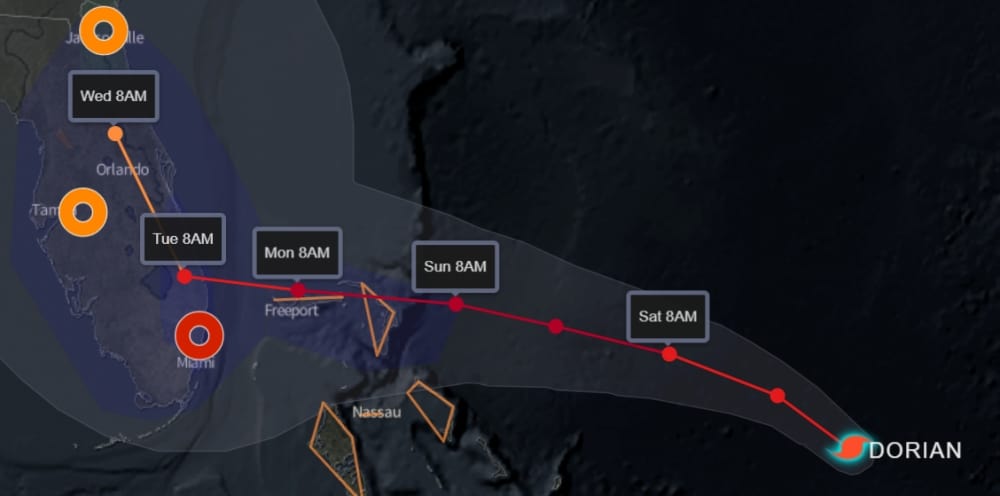As Hurricane Dorian barrels towards Florida’s Atlantic coast and threatens to make landfall as an extremely dangerous Category 4 storm, a number of key consequences loom for ocean shipping.
The storm has the potential to alter shipping services in multiple markets, in some cases for short periods, in others longer term. Fallout could be felt in four main areas: container transshipment, international mainline box services to and from Florida, regional cargo services to the Caribbean and tanker shipping.
Transshipment fallout
One serious potential consequence for ocean shipping does not involve Florida. It involves the island of Freeport in the Bahamas, which as of midday on Aug. 30 was directly in the center of the storm’s forecast track.

The Caribbean is home to the transshipment hubs that serve the entire Americas marketplace. Major east-west services from Europe and Asia drop off boxes for reloading on north-south and regional services.
The Freeport Container Port (FCP), operated by Hong Kong’s Hutchison, is one of the largest players in the Americas transshipment market, with an annual handling capacity of 1.5 million twenty-foot equivalent units (TEU). Other hubs in the Caribbean’s so-called transshipment triangle are in the Dominican Republic, Jamaica, Colombia and Panama.
If FCP were to be hit by Dorian and suffer major damage, there would be large-scale shifts in box flows across the region for an extended period as volume is pushed to other hubs, likely creating congestion.
This scenario is well-known – because it happened before. FCP was decimated in October 2016 by Category 4 Hurricane Matthew. It lost the majority of its gantry cranes and operated at only minimal levels for the following year.
FCP is an important hub for Mediterranean Shipping Company (MSC). Following Matthew’s devastation, some MSC volumes were moved to Caucedo in the Dominican Republic and Kingston in Jamaica, but most of the load was shifted to Cristobal on the Caribbean coast of Panama. Underscoring just how significant the effect was, Cristobal’s container volumes surged by 65% in 2017 versus 2016.
Before Hurricane Matthew, FCP was damaged in March 2010 by a tornado, leading to volumes pushed to Caucedo.
Multiple sources in the Caribbean transshipment sector have told FreightWaves that concerns about FCP’s weather vulnerability could lead MSC to consider less vulnerable transshipment options elsewhere. If true, this sentiment would only be reinforced by Dorian’s threat, which could theoretically lead to longer-term changes in the region’s transshipment landscape.
Mainline Miami services
The current storm track is directly towards Miami. The Port of Miami handled just over 1 million TEU in 2018, with China being by far the largest source of import containers and Honduras being the most important export destination.
Of the Port of Miami’s total TEU volume in 2018 (including both imports and exports), the Americas and the Caribbean accounted for 49%, Asia 33%, Europe 13% and the Middle East/India/Africa 5%.
All of the major container shipping alliances – 2M, Ocean Alliance and THE Alliance – have multiple services into Miami. Additional services are offered by individual liner companies including Hapag-Lloyd, CMA CGM, K Line and NYK.
As of midday on Aug. 30, the U.S. Coast Guard was anticipating a change to Port Condition Yankee within the coming hours. That condition would require cessation of all cargo handling and the departure of all ocean-going vessels from the port.
Caribbean shipping network
The Port of Miami, and Jacksonville to the north, serve as the home base for multiple smaller container shipping lines that serve the Caribbean and South/Central America.
Most of the islands in the Caribbean import almost everything they consume. While the source mix changes, the majority of island import volumes – comprised of retail and hospitality-related goods – are transported south from Florida by the smaller regional ocean carriers, with that cargo brought to Florida’s ports by trucks. Caribbean volumes are rounded out by goods from Europe and Asia that are transshipped to the islands via hubs.
Following a wave of consolidation in the regional shipping sector, the main players are: Seaboard; Antillean Marine; Saltchuk, which owns Tote Maritime (formerly Sea Star) and purchased Tropical Shipping in 2014; King Ocean, which bought Bernuth in 2012; and Crowley, which acquired SeaFreight in 2015.
The Jones Act services from Florida to Puerto Rico, which sail out of Jacksonville, are provided by TOTE Maritime, Crowley and Trailer Bridge.
Florida ship operators serving the Caribbean trade have extensive experience navigating hurricane-damaged ports of call in the islands. But the threat of Dorian is different, with possible impacts on their home ports and cargo supply chains.
Liquid bulk shipping
On the bulk shipping side of the equation, Florida has very little dry bulk trade, but has a high-volume liquid bulk trade. The state has no refineries and no significant pipeline access and is almost entirely supplied via coastal tankers and tug-barges bringing refined products from the U.S. Gulf Coast.
According to data from the U.S. Energy Information Administration, 253.1 million barrels of refined products were shipped from the U.S. Gulf to the lower Atlantic states (primarily Florida) in 2018, near an all-time record and up 27% from 2015. Volumes rose 9% year-on-year during the first five months of 2019.
Refined product deliveries will be halted as the storm nears, but disruptions in coastwise shipments to Florida would likely be short term unless important liquid-bulk import terminals and/or storage facilities are heavily damaged by Dorian.
As with container transport, the bigger potential fallout for tanker shipping lies not in Florida but in the Bahamas.
In addition to being the location of FCP, the island of Freeport is home to the Buckeye Bahamas Hub of Buckeye Partners. The Bahamas Hub is the largest petroleum products terminal in the Western Hemisphere. It has capacity to store up to 26.2 million barrels of petroleum and eight berths, including two capable of handling very large crude carriers – and as of Aug. 30, it was directly in the middle of Dorian’s projected path. More FreightWaves/American Shipper articles by Greg Miller










